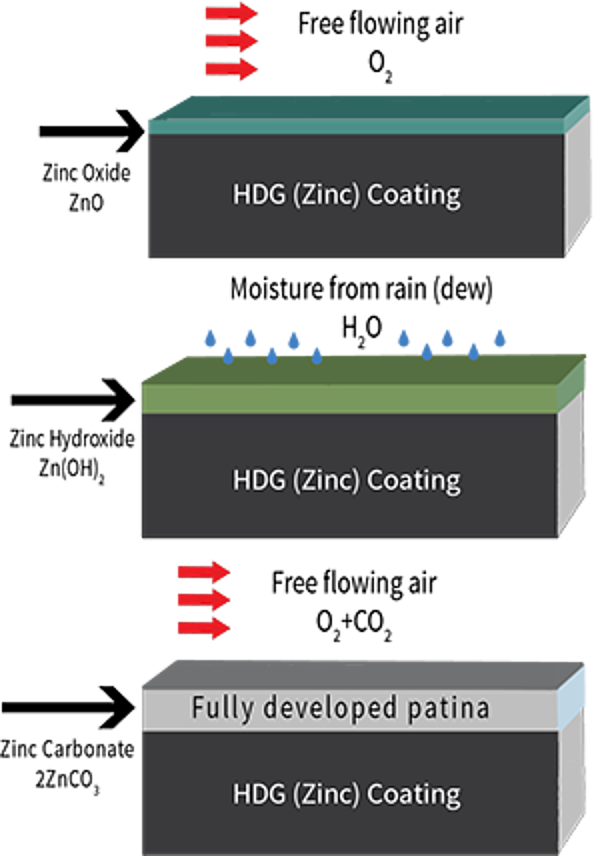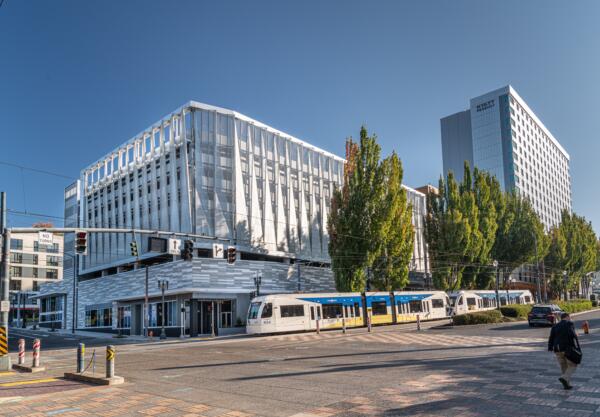Identify the Surface Condition
Determining the condition of the galvanized surface is critical in employing the proper surface preparation. Galvanized surfaces can be classified as newly galvanized, partially weathered, or fully weathered (paint) and newly galvanized or partially weathered (powder coating). Properly identifying the surface is important because each condition requires a different amount of cleaning and/or profiling.
Zinc Patina Formation

The hot-dip galvanized coating is formed when the iron in the steel reacts with the zinc in the galvanizing kettle. This metallurgical reaction is a diffusion process, creating a growth of intermetallic layers perpendicular to the steel surface. Zinc, like all metals, begins to corrode when exposed to the atmosphere. As galvanized coatings are exposed to both moisture and free flowing air, corrosion by-products will naturally form on the coating surface, called the Zinc Patina. The formation of these by-products (zinc oxide, zinc hydroxide, and zinc carbonate) occurs during natural wet and dry cycles in the environment.
The rate of zinc compound formation is determined by a number of variables, including the amount of time since the part was withdrawn from the kettle, the temperature of the part, and the humidity in the atmosphere. Identifying the state of the zinc patina formation will dictate what cleaning/profiling steps are required, and what surface condition (as found in the specs) you should follow.
For detailed instruction on preparing the surface, refer to ASTM D6386: Practice for Preparation of Zinc (Hot-Dip Galvanized) Coated Iron and Steel Product and Hardware Surfaces for Painting OR ASTM D7803: Practice for Preparation of Zinc (Hot-Dip Galvanized) Coated Iron and Steel Product and Hardware Surfaces for Powder Coating.
Newly Galvanized
Newly galvanized steel has been exposed to the atmosphere for no more than 48 hours and has few zinc compounds on the surface. The coating can be bright and shiny, indicating an all-zinc outer layer, or dull gray, indicating a zinc-iron intermetallic outer layer, or a combination of both.
Whether bright or dull, the key factor in the newly galvanized condition is a lack of zinc compounds on the surface, which simplifies the cleaning. Some newly galvanized parts, those with a dull gray, can have a rough surface texture, while bright and shiny parts are often smooth. Regardless if the surface is rough or smooth, profiling the surface by sweep blasting is necessary to ensure the adherence of the paint system.
Partially Weathered
Partially weathered galvanized surfaces have a build-up of zinc compounds and, possibly, organic contaminants such as dirt, dust, oil, or grease. The compounds become attached to the zinc coating by electrostatic forces and can be expected to release from the surface over time. The zinc compounds, mostly zinc oxide and zinc hydroxide, must be removed before painting.
If the parts are stacked too tightly or the humidity is excessive, partially weathered galvanized parts may show signs of wet storage stain. This white powder is created when zinc oxide and zinc hydroxide become excessive on the surface. If the partially weathered part shows signs of wet storage stain, the storage stain must be removed before the part can be painted.
Partially weathered galvanized steel is the most common galvanized surface condition when painting, and also the most difficult to prepare. The partially weathered surface condition is present from two days to about one year after galvanizing, depending on temperature variation and humidity factors.
Fully Weathered

Fully weathered galvanized steel has zinc compounds covering the entire surface. The main compound in the fully weathered surface is zinc carbonate.
Zinc carbonate tightly adheres to the surface, is not water soluble, and does not wash off the surface when water hits the part. In this state, the zinc compounds should not be removed, as the paint performs better when the compounds are left on the surface.
Fully weathered galvanized coatings are the simplest surface condition to paint. This condition is present from one year of exposure to the atmosphere until all the zinc coating has been consumed by protecting the underlying steel, which will take decades. Painting of weathered galvanized steel can significantly extend the service life of the corrosion protection system.